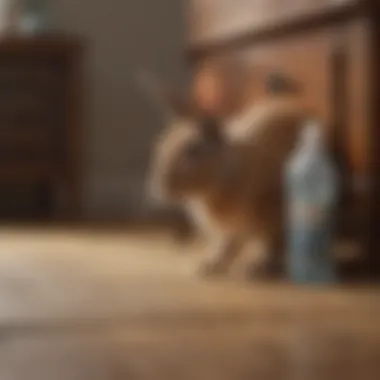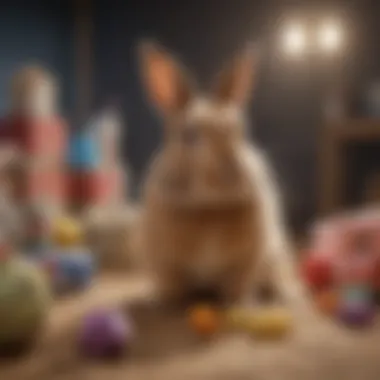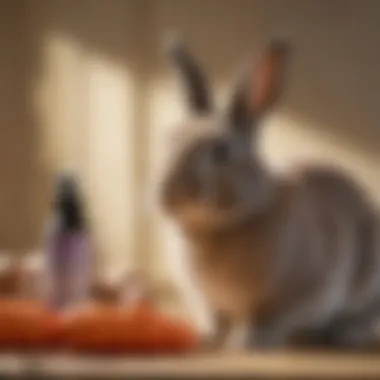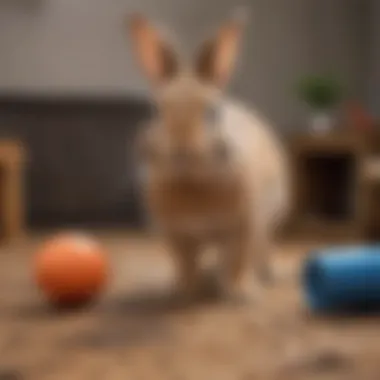Understanding No Chew Spray for Rabbits: A Comprehensive Guide


Intro
Rabbits are well loved by many pet owners. Their playful nature and soft fur make them enjoyable companions. However, they also have some unique behaviors, which can be challenging for new owners. One common issue is chewing. Rabbits naturally chew to maintain their dental health and explore their environment. Nevertheless, they might chew on inappropriate items like furniture, wiring, or even harmful substances. This is where no chew spray comes into play. Understanding this product and its application can greatly enhance the experience of owning a rabbit.
Understanding Your Pet
Pet Behavior Basics
To manage chewing behavior effectively, it is essential to grasp the underlying instincts of rabbits. Chewing is an innate activity that helps rabbits wear down their continuously growing teeth. It also relieves boredom and stress. Thus, punishing a rabbit for chewing isn't effective. Instead, pet owners should provide suitable alternatives.
Common Breed Characteristics
Different breeds of rabbits exhibit varied chewing tendencies. For example, breeds like the Holland Lop may chew more inquisitively than larger breeds such as the Flemish Giant. Recognizing individual breed characteristics can aid in predicting and managing chewing behavior more effectively. Remember, smaller breeds may require different adjustment strategies than larger ones.
Species-Specific Needs
Every rabbit is unique, but all share certain species-specific needs. These include a proper diet, appropriate chew toys, and safe spaces to explore. Understanding these requirements is fundamental in reducing unwanted chewing. Providing high-fiber hay, wooden chew toys, and ample room for exercise can satisfy their chewing instincts in a safe manner.
Pet Care and Maintenance
Feeding Guidelines
Proper nutrition is critical for rabbits. Hay should always be a staple in their diet, serving as a source of fiber for digestion and tooth health. Fresh vegetables complement this diet, while pellets can provide additional nutrients. Avoid feeding them sugary or starchy foods, as these can lead to health issues.
Grooming Essentials
Regular grooming keeps a rabbit's coat healthy and can reduce shedding. Brushing not only helps maintain their fur but also allows you to check for skin problems. Short-haired breeds may require less grooming than long-haired varieties, but all need some level of attention to their grooming needs.
Hygiene Practices
Keeping your rabbit's living area clean is vital for their health. Regularly clean bedding, change litter, and remove uneaten food. A clean environment reduces the risk of infections and promotes overall well-being.
Training and Development
Basic Commands and Skills
Basic training is beneficial for both pet and owner. Teaching your rabbit commands like “come” or “stay” can enhance communication. Using positive reinforcement, like treats or praise, can make training more effective.
Behavioral Training Techniques
Understanding behavioral training techniques is fundamental. For unwanted chewing, redirecting them to appropriate chew toys can be helpful. No chew sprays may also assist in discouraging them from certain objects.
Addressing Common Behavior Issues
Common issues include chewing furniture, litter box problems, and aggression. Each issue may stem from boredom, stress, or a lack of proper guidance. Identifying the root causes of these behaviors will lead to effective solutions, benefiting both the rabbit and the owner.
Health and Wellness
Routine Vet Check-ups
Regular veterinary check-ups are essential for ensuring that your rabbit stays healthy. A vet can check for common ailments such as dental problems or gastrointestinal issues. Keeping up with scheduled appointments can help detect potential health issues early.
Vaccination Needs
Rabbits should receive vaccinations against diseases such as myxomatosis and rabbit hemorrhagic disease. Consult with your vet for specific vaccination recommendations based on your location and your rabbit's lifestyle.
Recognizing Signs of Illness
Being aware of the signs of illness can help you act promptly. Symptoms such as lethargy, changes in appetite, or unusual behavior may indicate that your rabbit is unwell. If these signs appear, seeking veterinary advice quickly is crucial.


Enrichment and Activities
Indoor vs.
Outdoor Activities
Both indoor and outdoor activities are important for a rabbit’s physical and mental stimulation. Indoor activities can include obstacle courses made from cardboard, while outdoor play under supervision can allow them to explore safely.
Interactive Toys and Games
Interactive toys keep your rabbit engaged and mentally active. Toys that can be chewed safely, like wooden blocks or soft toys, can prevent unwanted chewing on household items. Rotate toys regularly to maintain their interest.
Socialization Opportunities
Socializing your rabbit is essential. Encourage positive interactions with family members and other pets. This builds a bond and reduces anxiety, which can often lead to destructive chewing behaviors.
Providing a safe and stimulating environment is fundamental to reducing chewing behaviors in rabbits. A happy, well-cared-for rabbit means fewer concerns about what they might chew.
Prolusion to No Chew Spray
No chew spray is a significant tool for rabbit owners. Understanding how it works and its purpose is crucial for ensuring a safe environment for these pets. Rabbits are natural chewers, and this behavior can lead to unwanted damage to household items and furniture. Therefore, no chew sprays can serve as an effective deterrent against this instinctual behavior.
Defining No Chew Spray
No chew spray is a type of product designed to discourage chewing. The composition of these sprays often includes bitter or unpleasant-tasting substances that are safe for rabbits but unappealing enough to deter them from chewing on furniture, electrical cords, and other items. These sprays are available in various formulations, catering to different preferences and needs. They are easy to apply and can be found in pet stores and online retailers.
Purpose of No Chew Spray for Rabbits
The primary purpose of no chew spray is to protect your furniture and personal belongings from the relentless chewing habits of rabbits. Additionally, it helps to ensure the safety and health of the rabbit. Chewing on inappropriate items can pose health risks, such as choking or intestinal blockages. By using no chew spray, pet owners can redirect their rabbit's chewing tendencies towards safe chew toys. This dual purpose makes it a valuable item for rabbit care. Furthermore, these sprays can foster a more harmonious living environment for both pets and owners, reducing stress and tension that may arise from destructive chewing behaviors.
Understanding Rabbit Behavior
Understanding rabbit behavior is crucial when it comes to managing their chewing habits effectively. Rabbits have unique instincts that drive them to chew, an action that serves multiple purposes. Comprehending these behaviors not only allows pet owners to address unwanted chewing but also promotes a deeper bond between them and their pets. Education on rabbit behavior can result in better welfare for the animals and enhanced satisfaction for owners.
The Natural Instinct to Chew
Chewing is a fundamental instinct among rabbits. In the wild, their teeth constantly grow, necessitating activities that wear them down. This natural behavior keeps their teeth at a manageable length and ensures that their oral health is maintained. Additionally, chewing serves as a form of exploration. Rabbits analyze their environment using their mouths, thus every texture provides valuable information.
Interestingly, domestic rabbits maintain these instincts. They will chew on various objects, sometimes leading them to damage household items or consume harmful substances. Understanding this instinct is key for pet owners. They must recognize that a rabbit’s urge to chew is not a deliberate act of defiance but an intrinsic characteristic.
Common Chewing Habits in Domestic Rabbits
Domestic rabbits exhibit various chewing habits that can often surprise their owners. They may chew on furniture, electrical wires, and even clothing. Such behavior may stem from boredom, anxiety, or simply the need to keep their teeth trimmed.
Some common chewing targets include:
- Furniture: Wood is particularly attractive to rabbits. Its texture and taste can prompt them to gnaw.
- Wires: Electrical cords can be seen as playthings, making them a danger if not managed properly.
- Household Items: Items like books or clothing are also at risk if left within reach.
It's essential to provide safe alternatives that fulfill their chewing instinct. Owners can offer rabbit-safe toys, cardboard, or appropriate chewables to redirect their attention.
By understanding these behaviors, owners can better implement strategies to manage chewing effectively. It fosters a safe environment where rabbits can express their instincts without causing damage or harm. Through supportive care and mindful interventions, pet owners can ensure both their rabbits and home stay secure.
Evaluating No Chew Spray Options
Evaluating the options for no chew sprays is critical in selecting the right product for your rabbit. A proper evaluation involves understanding the various types of available sprays, their ingredients, and their effectiveness. This section aims to provide insights into how one can make informed choices while promoting safe and healthy environments for rabbits.
Types of No Chew Sprays Available
There are several types of no chew sprays that pet owners can consider. Each type has its unique application method and active components. The most commonly found varieties include:
- Bitter Taste Sprays: These sprays contain bitter substances that deter rabbits from chewing on treated surfaces. The unpleasant taste discourages repeated chewing.
- Natural Sprays: Often made from essential oils or plant extracts, these types focus on being safe for both rabbits and the environment. They are considered more suitable for sensitive pets.
- Chemical-Based Sprays: These sprays may contain synthetic compounds. They can be potent in effect but raise concerns about long-term exposure and potential health risks for the animal.


When selecting a type, consider the specific chewing habits of your rabbit as well as its sensitivities to certain ingredients. Each rabbit is unique, and what works for one may not work as effectively for another.
Active Ingredients in No Chew Sprays
The active ingredients in no chew sprays play a crucial role in their effectiveness. Here are some common active ingredients found in no chew sprays:
- Bitterant Compounds: Such as denatonium benzoate, they provide a strong, unpleasant taste that discourages chewing.
- Natural Extracts: Citronella, clove oil, and rosemary oil often appear in natural sprays. These ingredients are less harsh and are generally safe for rabbits.
- Synthetic Chemicals: Some sprays may contain substances like ethyl alcohol or other chemicals meant to repel chewing. Caution is advised when using these, as they can pose risks to rabbit health if ingested in significant amounts.
It is essential for pet owners to read labels and understand the implications of active ingredients, ensuring they choose products that prioritize the well-being of their rabbits.
Understanding these components is vital for assessing the suitability of no chew sprays. Many brands provide detailed descriptions and ingredient lists, allowing you to make careful selections based on the needs of your rabbit.
In summary, evaluating no chew sprays requires a look into the types available and the active ingredients they contain. This evaluation aids in enhancing the quality of care provided to your pet and mitigates potential health risks associated with inappropriate products.
How to Apply No Chew Spray
Understanding how to properly apply no chew spray is crucial for pet owners. Effective application promotes a safe environment for rabbits while minimizing the risk of undesirable chewing behavior. Proper use of these products can help protect both your belongings and the well-being of your pet.
Best Practices for Application
To ensure the effectiveness of no chew spray, it is essential to follow best practices during application. These techniques make certain that the spray is used correctly and achieves desired results.
First, identify the areas where your rabbit tends to chew. This may include furniture, wires, or specific corners in their habitat. Focus on these areas during application. When spraying, hold the bottle approximately six to twelve inches away from the surface. This distance prevents over-saturation and allows for even coverage.
Ensure that the area is clean and dry before application. Dirty surfaces may interfere with the effectiveness of the spray. Moreover, it is advisable to apply the no chew spray during a time when your rabbit is not in the vicinity. This limits their exposure to the spray and helps avoid any distress.
Finally, reapply the no chew spray as recommended by the manufacturer. Most products require frequent applications, especially after cleaning or if the scent fades. Consistency in application increases the likelihood of discouraging unwanted chewing behavior.
Safety Precautions During Use
Using no chew spray necessitates certain safety precautions for both rabbits and their owners. Keeping these considerations in mind ensures a safer and more effective experience.
Before using, always read the label. Familiarize yourself with ingredients and usage instructions. If any component is harmful when ingested, keep your rabbit away from treated areas until dry. Always ventilate the application area well to prevent strong chemical odors from causing distress.
Additionally, consider wearing gloves during application. This safeguards your own skin from potential irritation caused by concentrated ingredients in the spray. In case of accidental contact with your skin or eyes, wash immediately with water. Seek medical advice if needed.
Another point to keep in mind is to monitor your rabbit after application. If any signs of allergic reactions or unusual behavior occur, discontinue use and consult a veterinarian. This careful approach helps maintain the health and happiness of your pet.
Effective application of no chew spray can significantly reduce destructive habits in rabbits.
By adhering to these best practices and safety precautions, you can use no chew spray effectively. This not only helps protect your belongings but also supports your rabbit’s well-being in a balanced manner.
Assessing Effectiveness
Assessing the effectiveness of no chew spray for rabbits is crucial for several reasons. First, it helps pet owners understand whether the spray is achieving its intended purpose—discouraging rabbits from chewing on unwanted items. Moreover, determining the success of the spray can prevent further damage to household belongings and ensure the safety and well-being of the rabbit. Assessing effectiveness also allows for adjustments in behavior modification strategies, ensuring that both the pet and its environment remain intact and enjoyable.
How to Gauge Success of No Chew Spray
To gauge the success of no chew spray, one must employ a systematic approach. Here are some steps to consider:
- Observation: Monitor your rabbit's behavior closely after applying the spray. Note any changes in chewing habits over time.
- Evaluate Target Areas: Check the specific areas where the spray was applied. Look for visible evidence of chewing or gnawing.
- Consistency: Consistent application is key. Ensure you are following the manufacturer's instructions on reapplication frequency.
- Behavioral Changes: Document any significant reductions or increases in your rabbit's chewing from before and after spray application.
Additionally, some owners found it helpful to keep a log of their observations. This record can reveal patterns or concerns over time, assisting in understanding the effectiveness.
Common Issues and Solutions
Despite efforts, some rabbits may remain undeterred by no chew spray. Here are common issues and their potential solutions:
- Ineffective Application: If the spray is not evenly applied, it may not provide sufficient deterrent. Make sure to cover the desired area thoroughly during application.
- Rabbit Desensitization: Some rabbits may become accustomed to the spray’s taste or smell. In this case, switching to a different brand with varied active ingredients may help.
- Environmental Factors: The surrounding environment can greatly affect the efficacy of the spray. Removing alternative chewing materials, such as old furniture or cables that are within reach, can minimize the urge to chew.
- Behavioral Issues: If the rabbit continues to chew, consider behavioral enrichment or training techniques. Offering appropriate chew toys may redirect their chewing instincts towards acceptable items.
It's important that pet owners continuously adapt and reassess their strategies to create the best environment for their rabbits.


In summary, gauging the success of no chew spray involves careful observation and an understanding of your rabbit's behavior. Addressing common issues promptly can ensure a smoother experience for both the pet and owner.
Alternatives to No Chew Spray
Understanding alternatives to no chew spray is essential for rabbit owners seeking effective, humane ways to manage their pet's chewing behavior. While no chew sprays can deter unwanted gnawing, various strategies exist that align with rabbit welfare and promote positive behavioral change. By considering these alternatives, pet owners can create an environment that is conducive to a rabbit's natural behaviors while also protecting their belongings.
Behavioral Training Methods
Behavioral training methods can play a pivotal role in reshaping a rabbit’s chewing habits. These techniques focus on communication and reinforcement, creating a bond between the pet and its owner, which is fundamental in altering behavior.
- Positive Reinforcement: This method involves rewarding desirable behaviors rather than punishing unwanted ones. When a rabbit chews on appropriate items, such as toys or hay, offering treats or affection reinforces the positive action.
- Consistent Commands: Use of verbal commands can help guide the rabbit. A clear command, paired with consistent training, aids in correcting unwanted behaviors. When your rabbit responds to commands, the result can reinforce that good behavior.
- Redirecting Attention: When rabbits start to chew on furniture or wires, redirect them to a chew toy. This teaches them which items are acceptable to chew. Offering a variety of safe chewables helps keep their interest focused in a positive direction.
Environmental Modifications
Environmental modifications are another effective alternative, creating a space where chewing becomes less of an issue.
- Chew-Proofing Areas: Consider using protective coverings for furniture or hiding exposed wires. Deterrents can include placing bitter-tasting sprays on non-harmful surfaces or using chew-proof materials.
- Providing Chew-Friendly Spaces: Designate areas specifically for chewing. Filling these spaces with safe materials such as untreated wood, cardboard, or commercial chew toys encourages rabbits to explore their natural chewing instincts without causing damage.
- Increase Physical and Mental Stimulation: Boredom can lead to undesirable chewing. Regular play and interaction enrich a rabbit’s environment. Use tunnels, hiding places, and puzzle feeders to engage their instincts and reduce attention on forbidden items.
Effective alternative methods foster a positive relationship and cultivate an environment that allows for natural behaviors while minimizing harmful chewing.
These alternatives not only address the immediate concern of destructive chewing but also promote a deeper understanding of rabbit behavior. Investing effort into effective behavioral training and environmental adjustments may ultimately serve as a more holistic approach to rabbit care.
Ethical Considerations
When discussing the use of no chew spray for rabbits, ethical considerations play a significant role. It's crucial to evaluate how these products affect rabbit welfare and to ensure that all actions taken are in the best interest of the animal. Understanding the ethical implications is essential for responsible pet ownership and the welfare of rabbits in domestic settings.
Impact of No Chew Sprays on Rabbit Welfare
No chew sprays are designed to deter chewing behavior in rabbits. However, the impact of such products must be examined closely. Some sprays contain strong or bitter ingredients that can cause discomfort. While they may effectively hinder chewing, it is important that the sprays do not cause harm or stress to the rabbit. A responsible pet owner should always opt for sprays that are safe and non-toxic.
It is essential to monitor the rabbit's behavior and health after using any no chew spray. If adverse reactions occur, the spray should be discontinued immediately. Frequent use and over-application can lead to long-term effects on a rabbit’s mental and physical wellbeing. Thus, always consider the ethical ramifications before introducing no chew sprays into a pet rabbit's environment.
Responsible Pet Ownership Practices
Responsible pet ownership involves several key practices that ensure the health and happiness of rabbits. First, pet owners should thoroughly research the products they use, understanding not only their effectiveness but also their ingredients. This diligence prevents harm and promotes ethical pet care.
Additionally, pet owners should implement positive reinforcement techniques to manage chewing habits rather than relying solely on deterrents like sprays. Training can foster better behavior without compromising the rabbit's comfort.
Here are some practices to consider as part of responsible pet ownership:
- Research Products: Always check product reviews and consult veterinarians before using no chew sprays.
- Monitor Behavior: Observe any changes in your rabbit's behavior or health after applying no chew spray.
- Create a Safe Environment: Remove items that rabbits commonly chew that may be dangerous or harmful.
- Employ Positive Reinforcement: Use treats or praise to encourage desired behaviors while discouraging unwanted chewing.
By focusing on these practices, pet owners can promote a healthier home for their pet rabbits. Ensuring their welfare should always take precedence in decisions surrounding pet care.
Culmination
In this article, the importance of no chew spray for rabbits has been thoroughly examined. It serves not only as an effective tool for managing rabbits’ natural chewing instincts, but also addresses broader implications for their overall welfare. Many pet owners encounter frustration when rabbits chew on furniture, cords, or other unsuitable items. This is where no chew spray comes into play.
The discussion of no chew spray's effectiveness reveals that it is more than just a deterrent; it can help create a safer environment for both the rabbit and the household. By understanding the right methods to apply these sprays, pet owners can tailor their approach according to their rabbit's behavior. This consideration ensures that the rabbit's well-being is priority, avoiding punitive measures that could harm their trust.
Summarizing Key Points
Key points from this discussion include:
- Purpose of No Chew Spray: It helps redirect unwanted chewing behavior.
- Application Techniques: Proper methods ensure effectiveness and safety.
- Effectiveness Evaluation: Monitoring your rabbit's response is crucial.
- Ethical Considerations: Mindfulness about pet welfare is needed.
- Alternative Methods: Behavioral training and environment modifications may also help.
These points highlight how integrative care approaches can effectively reduce inappropriate chewing without compromising the rabbit's natural behavior.
Final Thoughts on Pet Care
In closing, responsible pet care extends beyond managing behavior. Understanding the underlying instincts of rabbits leads to more effective solutions. No chew sprays can be a significant part of that strategy.
Furthermore, it is essential for pet owners to remain educated about their animals’ needs. Each rabbit is unique, and different methods may resonate with different animals. Engaging with community resources, such as forums and websites, can provide additional insights and support.
Ensuring a safe environment for rabbits is not just about preventing damage, but also about enhancing their quality of life.
In sum, whether using no chew spray or exploring alternatives, the focus should always remain on the health and happiness of the rabbit.







